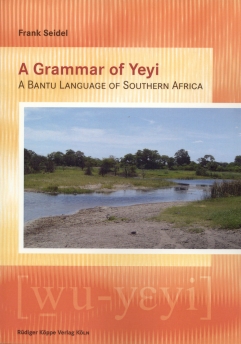


Yeyi / Siyeyi (R.40) is a Bantu language spoken in the Eastern part of the Caprivi Region of Namibia (Caprivi Strip) and in and around the Okavango Delta situated in the Ngamiland Province of Botswana. Yeyi speakers in Botswana and in Namibia regard the present-day Caprivi Strip as their ancestral homeland. The exodus of Yeyi people from places like Nkasa and Lupala islands in the Linyanti swamps, presumably around 1750, resulted in the differentiation of Yeyi speakers into two groups: the speakers of Ngamiland / Botswana and the speakers of the Caprivi Strip / Namibia, whose variety formed the basis of the present description.
Today Yeyi is spoken by about 25,000–30,000 people as a first or second language in the Ngamiland Province and by around 5,200 people in the Caprivi Region of Namibia. Owing to the different historical developments in the two areas Yeyi speakers nowadays live and act in two different sociolinguistic settings. Common to both of these settings is that in the direct neighbourhood several Khoisan as well as Bantu languages exist and existed, of which some must have heavily influenced Yeyi. This linguistically and ethnically highly heterogeneous background lead to a situation of language shift in Botswana, while in Namibia the Yeyi community is characterized by stable multilingualism.
Yeyi with its agglutinating character, its fully functional class and concordance system, and its several, Bantu typical verbal derivations is a classical Bantu language. This description is synchronically oriented and primarily morphosyntactical in nature. However, it additionally aims at presenting extensive language data on Yeyi, accompanied by a description which presents a useful basis for further use in comparative studies and linguistic typology.
Thus, this work also intends to expand the general knowledge about Bantu languages. In this context the tense-aspect system and its interdependency with pragmatic issues, or more specifically, the interaction of tense-aspect morphology and past narrative texts, formed a field of particular interest.
Under these links you will find publications by the author and descriptions of neighbouring Bantu languages, cultures and their history in southern Africa:
Lastly, saying the volume is good and elaborate cannot, in my view, suffice, nevertheless I should just stipulate here that Frank Seidel has strived to gather a bulk of data and has made good efforts to give the best description in order to make sure that the reader gets the perfect reflections of what exists in Yeyi language.
Amani Lusekelo in Afrikanistik online, www.afrikanistik-online.de/archiv/2009/2027, 1-5
[...] the book provides a comprehensive and very detailed description of Yeyi, based on an extensive range of textual narratives and elicited data and thus providing ample illustration of the major and many minor structures of the language. [...]
The few examples chosen here to give an impression of Yeyi grammar suffice to show the great interest the language has for researchers in the fields of comparative Bantu typology or theoretical linguistics. While the present book does not particularly invite the cursory check for a specific grammatical feature, it contains so much interesting material that a slightly mere thorough engagement is warranted. For me personally reading the book from cover to cover was certainly most rewarding.
Lutz Marten in Afrika und Übersee, 91/2010, 137-140
Seidel’s grammar of Yeyi provides a rich data collection embedded into a solid Bantu descriptive framework. It has to be regarded as a very valuable contribution to Bantu studies in general and to the investigation of south-western Bantu languages in particular. It will surely stimulate future research in a fascinating multilingual border region between Namibia and Botswana and can be seen as a milestone in Yeyi synchronic description which future research into pragmatics as well as contact linguistics will be able to build on.
Gabriele Sommer in Journal of African Languages and Linguistics, 31/1, 2010, 142-144
© 2026 by Rüdiger Köppe Verlag – www.koeppe.de